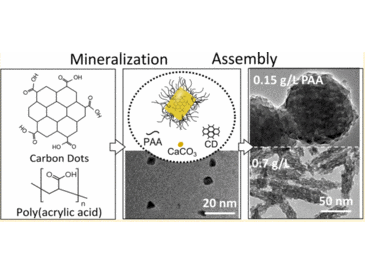Victor Lauth, Brigitta Loretz, Claus-Michael Lehr, MichaelMaas, Kurosch Rezwan.
Chemistry of Materials (2016) 28, 3796-3803
https://pubs.acs.org/doi/abs/10.1021/acs.chemmater.6b00769
We describe a platform for the synthesis of functional hybrid nanoparticles in the submicrometer range with tailorable anisotropic morphology. Fluorescent carbon dots (CDs) and poly(acrylic acid) (PAA) are used to modify the crystallization and assembly of calcium carbonate (CaCO3). Carboxylic groups on CDs sequester calcium ions and serve as templates for CaCO3 precipitation when carbonate is added. This creates primary CaCO3 nanoparticles, 7 nm in diameter, which self-assemble into spheres or rods depending on the PAA concentration. At increasing polymer concentration, oriented assembly becomes more prevalent yielding rod-like particles. The hybrid particles show colloidal stability in cell medium and absence of cytotoxicity as well as a loading efficiency of around 30% for Rhodamine B with pH-controlled release. Given the morphological control, simplicity of synthesis, and efficient loading capabilities the CD-CaCO3 system could serve as a novel platform for advanced drug carrier systems.


